
The percentage of Node.js careers is increasing, which directly relates to the growing competitiveness. This requires the most thorough preparation possible. You may also refer to Node.js best practices for your practical understanding and this article for your theoretical one!
This blog of top Node Js interview questions has been carefully chosen to provide you with solutions to some of the most often asked Node JS interview questions. By following the advice meticulously, you may gain the strategic advantage necessary to nail your Node js interview. We have also tried to cover some advanced node.js interview questions for all those experienced developers out here reading this blog.
Node.js is an incredibly robust framework built on Google Chrome’s JavaScript engine, which immediately converts JavaScript into native machine code. It is a small framework for developing server-side web-based apps that extends the JavaScript API to provide common server-side functionality. It is typically used for developing server software, large-scale programs, particularly online streaming websites, single-page apps, and other online applications.
1. Top Node.js Interview Questions
Following are the top Node.js interview questions:
1.1 How Does Node JS Work? Which Types of Apps are Developed Using Nodejs?
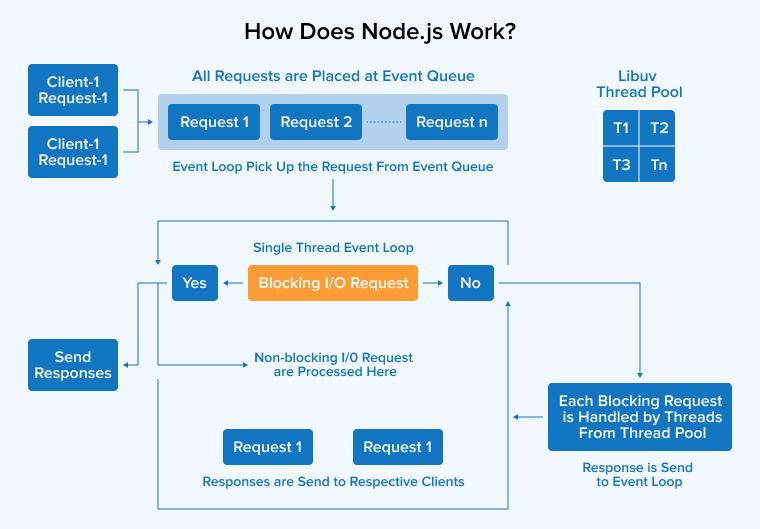
The first and foremost question about Nodejs revolves around how Nodejs works. To answer that, you must know that Nodejs works on a virtual V8 environment that uses JavaScript code as its scripting language to achieve high output using non-blocking I/O and a single-threaded event loop. Node.js works in an event loop which is provided by a special library called “Libuv,” as per the Node.js developers. When asked about Nodejs functioning, you must also know that Node.js processing architecture is heavily influenced by the Javascript event-based model and the callback function/ mechanism.
Some of the most popular types of Node.js applications available in the market are:
- Single-Page Applications: Node.js is used for creating single-page applications as it has the capability to handle heavy input/output workloads, asynchronous calls, and more. In addition to this, with the help of Node.js SPAs can have a seamless transition of data between the server and the view.
- Real-time Collaboration Tools: Node.js is one of the most popular engines when it comes to creating real-time collaboration tools which include collaborative document editing tools, video & audio conferencing tools, and more.
- Location-based Applications: The majority of the location-based applications in the market are created using Node.js. The reason behind it is that Node offers asynchronous programming and event-based architecture.
- Real-time Applications: Creating real-time applications with Node is the best decision as it enables developers to create applications like instant messaging apps, internet relay chat, and more.
- Streaming Applications: Streaming applications are created using Node.js where developers utilize stream API to easily handle real-time data streams and also synchronize data quickly between the client and the server.
1.2 What is NPM & Functionality?
When it comes to Node, there is a special package handler called NPM- Node Package Manager, it is in charge of handling all of Node.js’ packages and modules. NPM (Node Package Manager) manages the majority of functions. If you want to find online repositories for node.js packages and node module/s then use the search.nodejs.org function. Also, if you want to install Node.js packages and maintain their versions and dependencies, you can do it easily using a command-line utility.
1.3 How Would You Differentiate Between Frontend and Backend Development?
| Characteristics | Frontend | Backend |
|---|---|---|
| Meaning | Frontend development means the client side of the app. | Backend development means the server side of the app. |
| Role | Frontend is a part of the application which users can interact with. | The backend is the part of the application that contributes to everything that happens behind the scenes. |
| Essentials | The essential languages for front-end development are JavaScript, CSS, and HTML. | The essential languages for backend development are Ruby, Python, PHP, Java, .Net, and more. |
| Developer | In frontend, the most common job title is web designer. | In the backend, the most common job title is backend developer. |
| Summary | Frontend is something that contributes to the visual aspect of the application. | The backend is something that enables the communication database to respond to the server request and display it. |
Such questions are asked just to check the roots and the understanding of the concept. So for your answer, you must know that when we’re developing a user interface of an application it is referred to as the front. While on the other hand, the server side of a program is referred to as the backend. The front-end side of the application can be used by users to see and interact with it as part of a web application. Everything else that occurs behind the screens is included in the backend category. It usually refers to everything related to a web application’s aesthetic appearance. To serve requests, it usually contains a web server that interfaces with a database. This part of the request is handled by the Backend.
If you are asked what Node Js is a backend or frontend development language. You must answer that Nodejs is a backend development programming language that has JavaScript as a core function.
1.4 Differentiate between Node.js vs Ajax
The primary distinction between Node.js and Ajax is that Node.js is a server-side Javascript code, while Ajax is a client-side technology. Ajax is a client-side scripting approach and is mostly used to update or alter the contents of a webpage / Web application without having to reload it. Whereas Nodes.js is a server-side framework for developing client-server side web applications.
Here is what Quora users have to say about Node vs Ajax:
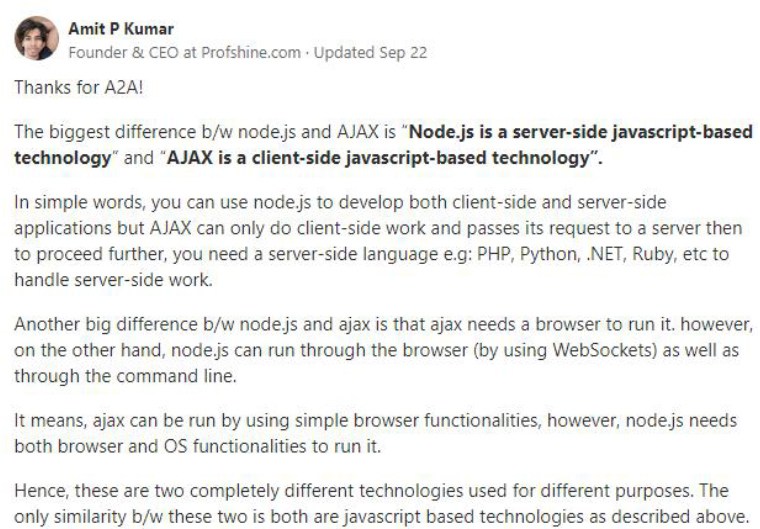
1.5 How Would You Define the Term I/O?
Any program, activity, or device that acts as a mediator to transfer data from one media to another is referred to as I/O- input-output. Every transfer is a result of one medium’s output and the input of another. For an input/output. In this way, a physical device, a network, or files within a system can be used as the medium between your internal system and external devices. And once this process is completed, it pushes the result to the event queue. Now what is the event queue you may ask? Well if JS is busy in some task then it will queue that event and once the JS is available it will provoke the next event in the queue (or event queue).
1.6 What Makes Asynchronous and Non-Blocking Different Concepts From Each Other?

Nonblocking replies instantly if the data is accessible and if it is not, it simply provides an error. Asynchronous does not react immediately. Asynchronous increases efficiency by doing activities quickly while waiting for a response; in the meanwhile, additional tasks can be completed. Non Blocking prevents any execution from being halted and it fetches data rapidly if it is accessible. Nonblocking I/O is the polar opposite of blocking I/O. However asynchronous is utilized for a larger variety of tasks, whereas non-blocking is generally used for I/O.
1.7 Define Callback Function in Node.js
In node.js, the callback function is used when there are multiple server requests. If you have a huge system with many files that would take more than expected time for a server to read then you need to have a callback method. You don’t want the server to make way to requests so, you may utilize the callback method. The call back function lets the server take care of any pending requests first, then call a function after they’re done. Callback functions are a big part of Node.js. Node’s APIs are built with callbacks in mind.
Example 1: Code for reading a file synchronously (blocking code) in Node.js. Create a text file file-to-read.txt with the following content:
Hello World! My First Program! Create a sync.js file with the following code: // Write JavaScript Code var fs = require("fs"); var data = fs.readFileSync(‘file-to-read.txt'); console.log(data.toString()); console.log("End of the Program"); |
Explanation: fs library is mainly used to handle file-system related tasks. Function readFileSync() is synchronous and blocks other executions until it is finished. Once it reads the file, then only it proceeds for the next steps.
Output:

Example 2: Code for reading a file asynchronously (non-blocking code) in Node.js. Create a text file file-to-read.txt with the following content.
Hello World Create a readfile.js file with the following code: // Write a JavaScript code var fs = require("fs"); fs.readFile('file-to-read.txt', function (error, data) { if (error) return console.error(error); console.log(data.toString()); }); |
Explanation: Here, the function readFile() works asynchronous. So, other tasks also execute while this function reads the file in the background.
Output:

1.8 What Do You Understand About Event Loop in Node.js and Its Functioning?
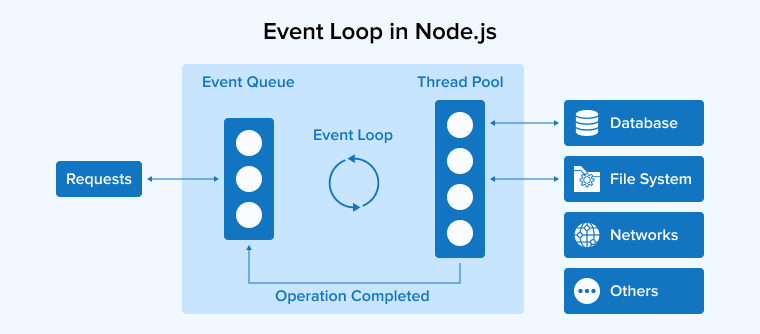
One of the most talked-about aspects of Node.js is the event Loop. An event loop in Node.js manages all of an application’s asynchronous callbacks. It is one of the most significant components of Node.js and the cause for the non-blocking I/O in Node.js. Since Node is an event-driven language, there is always a listener that performs the callback function whenever an event occurs.
According to nodejs.org event loop can be described as:
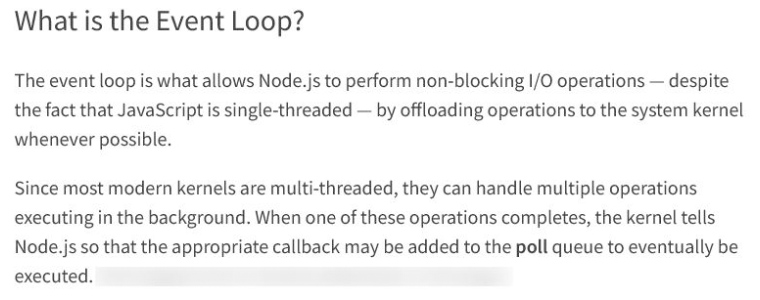
Node.js executes the event loop whenever methods like setTimeout, http.get, and fs.readFile are used and then continues with the rest of the code without waiting for the output. When the operation is complete, Node.js receives the output and calls the callback function. This is why all of the callback functions are put into a loop in a queue. They are carried out one by one after receiving the response.
In simple terms, when you want to process or handle requests coming from external sources then you need to convert them into callbacks. There are invocations occurring from the event loop which can help the node js function to switch from one request to another. Also as we know that node.js is single threaded and it uses async function calls/ asynchronous function calls for maintaining concurrency.
The main loop is single-threaded and all async calls are managed by libuv library.
For example:
console.log("First Statement"); setTimeout(function(){ console.log("Third Statement"); }, 1000); console.log("Second Statement"); |
Output:

1.9 Explain the Purpose of Express JS Package
To know the function of the Express.js package, you must first know what express.js is and what importance it holds in Nodejs. Express.js is a flexible web application framework in Node.js with a broad array of features to develop all types of mobile and web applications. Express.js is a Node.js-based framework for managing the flow of data between the server and server-side web applications. It’s a lightweight and adaptable framework with a variety of capabilities for online and mobile app development. Connect, a Node.js middleware module serves as the foundation for Express.js. In order to communicate with Node.js, the connect module uses the HTTP module. As a result, you can simply combine Express.js with any connect-based middleware module.
Here is what a Quora user has to say about the purpose behind using Express JS.
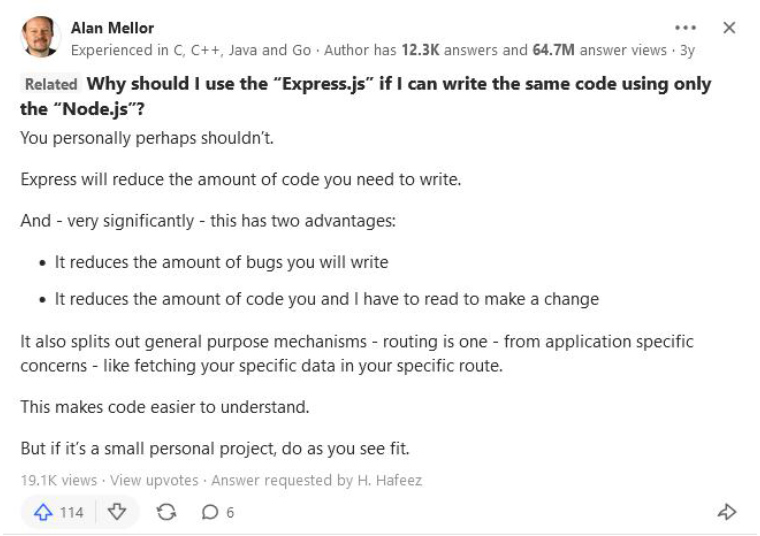
Because Express is a Nodejs framework, knowing more about Express js will give you an extra boost to your profile when you’re preparing for Nodejs interview questions.
1.10 What Does Event-Driven Programming Mean?
Whenever you build your application in a way that responds to events then you have used event-driven programming. It goes as the name event-driven programming means programming driven by a sequence of events. Like if we run a callback function that is registered to the element for that event so whenever an event happens, you respond by clicking or keypressing. Also when an event is triggered, a call-back function that has previously been registered with the element is called. The majority of event-driven programming follows a publish-subscribe approach. This makes the process faster and more interactive.
1.11 Why is Node.js Single-Threaded?
Node.js was built especially for async processing. It is thought that performing async processing on a single thread can offer more speed and scalability than a typical thread-based implementation/approach under average web loads.
1.12 Explain REPL in the Context of Node.js
REPL stands for Read, Eval, Print, and Loop in the setting of Node.js. REPL is a type of interactive computer environment (akin to a Windows console or Linux shell) in which each command typed produces system-generated output. By default, Node.js has a REPL environment that executes the assigned objectives:
- Read: Reads the user’s input and transforms it to a JavaScript code/data model, which is then stored in memory.
- Eval: It collects and assesses the data structure.
- Print: It prints the completed result.
- Loop: It executes the specified command indefinitely until CTRL + C is pressed twice.
See the Example:
$ node > 500 - 300 200 > 10000/2 5000 > |
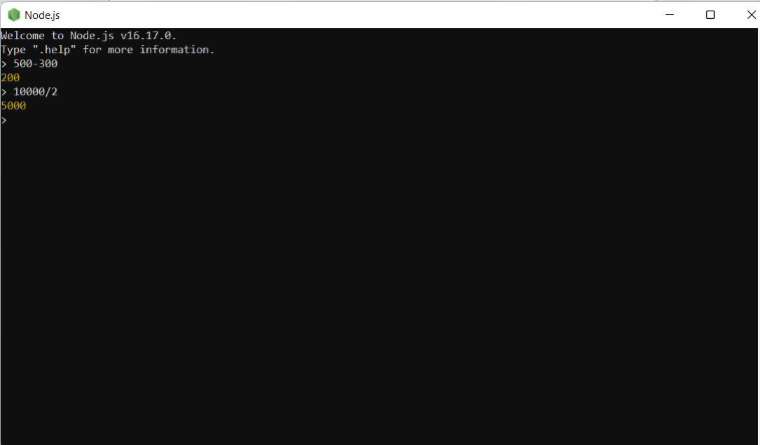
1.13 What is the Command Used to Import External Libraries?
The command “require” is performed to acquire external libraries. “var http=require (“HTTP”), for instance.” Using the HTTP parameter, this will install the HTTP library and the single exporting object.
2. The Advantages of Node.JS
Some of the most appealing features of Node.js is the ease with which developers can grow applications both horizontally and vertically. By adding extra nodes to the current system, the applications may be grown horizontally. Starting to use Node.js on the backend becomes considerably easier for them.
Learning Node.js is simpler and working with it takes less time. Node.js programmers may use a js runtime environment to create both the front-end and back-end web applications in JavaScript. Because the runtime environment provides non-blocking I/O operations, the performance of code execution is also improved. NPM (Node Package Manager) robust package management may be used to detect and install project dependencies.
Nodejs is quite competent when it comes to web application development and hence we know there are developers (both experienced as well as amateur) who want to try their hands in Nodejs development.
3. Conclusion
Node.js, a runtime JavaScript environment, has become the most preferred alternative for constructing backend web applications that use RESTful APIs to interface with server-side databases including MongoDB or NoSQL.
Additionally, Node.js is leveraged to construct apps for the storage and manipulation of massive data-intensive online and network apps that are event-driven and reactive in nature.
Node.JS is one of the most effective web development technologies available in recent years. It is built on JavaScript and enables you to be adaptive to the majority of web development settings.
If you intend to recruit a Node JS professional, you should be aware of the appropriate questions to ask. If you carefully review the node.js interview questions and answers covered in this post, you will also have a decent understanding of what to expect from the applicant. Similarly, as an application, you will get to know a lot of things if you’re preparing for a Nodejs profile.
I wish you success in scaling your company and recruiting! Best of luck!
More interview questions:
Angular Interview questions


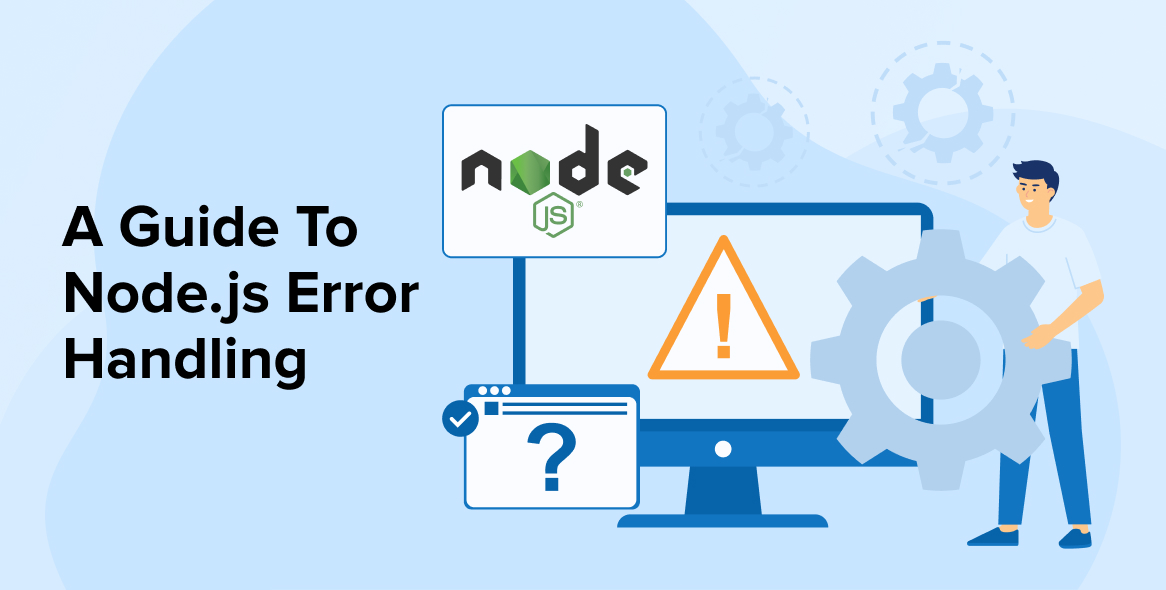
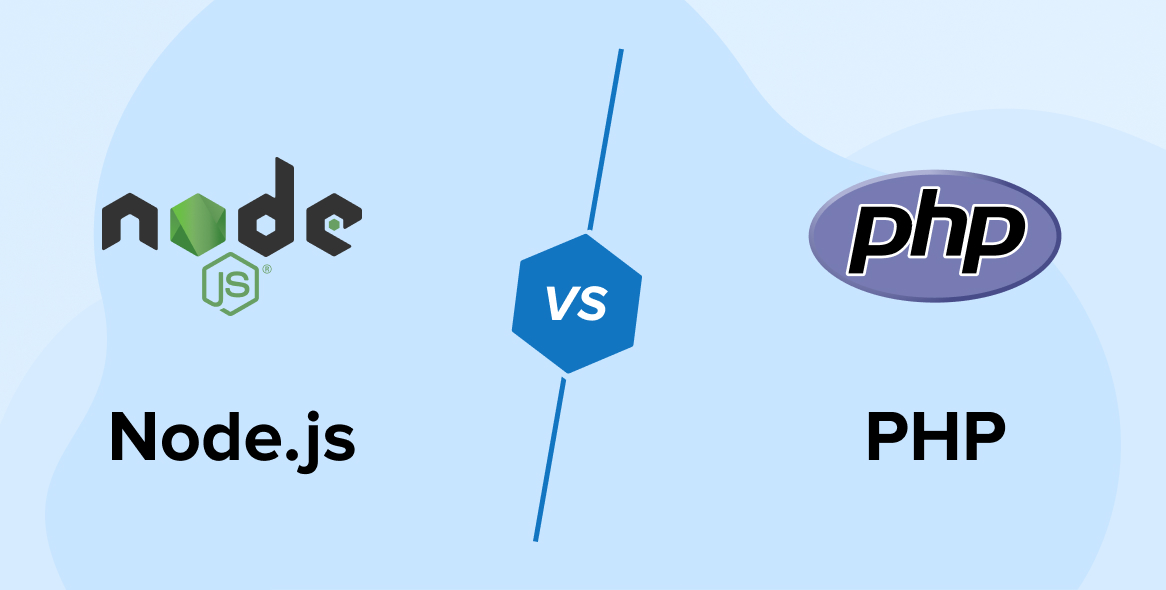
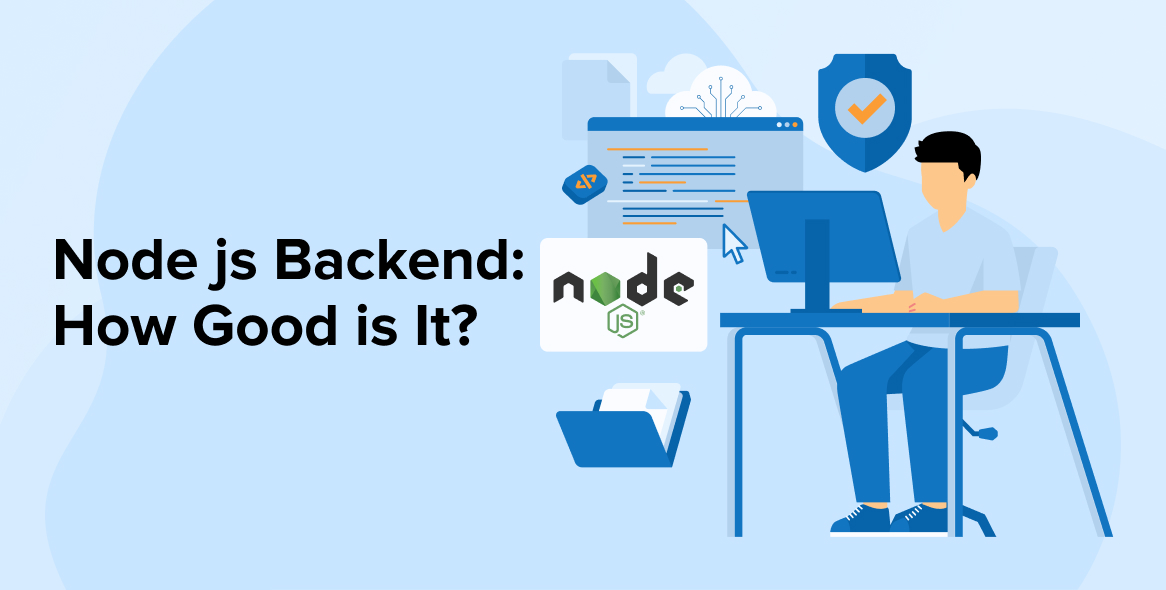

Node.js careers are rising now, which is directly related to the growing competitiveness. This article really helped me out when I was trying to ace my Node.js interview. You mention each and every Node.js interview question that has been asked. Keep Sharing!
Thank you so much for providing this insightful article on Node.js interview questions! I found the questions and explanations were quite detailed and helpful. Keep up the great work!
This article covers All Node.js topics and provides insights into the Primary factor of Node.js development. Thank you for providing this information and helping the Node.js community with better interview preparation.
The article discusses some essential and important questions that every Node.js developer must know. It's a time-worthy and informative read!